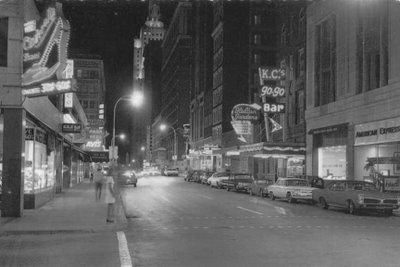
Damn it. I need to start bringing a camera with me. Instead, y'all get web ripoffs from a bunch of different periods (which, actually, are almost certainly better than my unschooled stabs at photography anyway).
Today, a brief visit to Kansas City. This place is Eden for a nostalgia whore; it takes less imagination to see a bustling American metropolis of 50 or 80 years ago looking at Kansas City than any other city I've visited. And this is mostly because so much of the turn-of-the-last-century architecture remains intact. The shot from the air shows the usual big glass skyscrapers, but on the ground there are hundreds of these old buildings, really making up the bulk of the city's indoor space. I noted the proportion of old-to-new buildings, and the percentage of the old ones that were abandoned and boarded up, when I was here over the winter. But at that time, it seemed as though there was nobody in the city. The downtown seemed bathed in the light of what used to be. Not a pall of death, exactly, but the absence of vitality. Everything was closed by 4:30 in the afternoon. Today as I walked South from the hotel toward the Liberty Memorial in the 80 degree heat I passed at least 20 older warehouses that were being actively renovated, transformed into condos or apartments or businesses or some combination. The city seemed much busier, with lots of traffic and people walking, street vendors, taxis, construction vehicles.
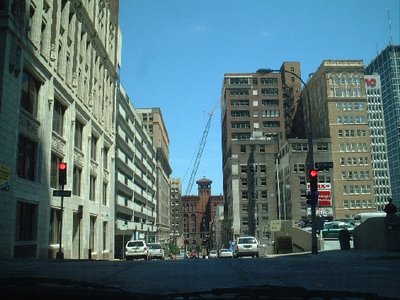
I can't help speculating about whether the existence of these old buildings--the raw material for all this historical restoration--was the result of a peculiar economic malaise. Why else are there so many of them when, in other similarly-sized cities, they've all been torn down for newer things? There is a sense that KC was really bustling at one time and somebody kind of turned off the tap. A lot of stuff got boarded up in a short span of time. That's how it seems. And now, block by block, these old structures are being bought up (for a relative song, I bet) and given rebirths as the city becomes something new.
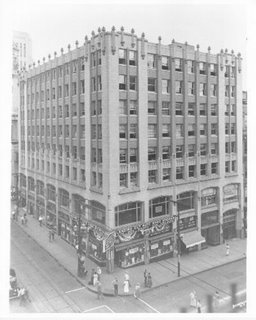 And thank god the buildings weren't all razed for a collection of concrete- and trash-strewn vacant lots. This concentration of historical structures--all from a fairly circumscribed period, say, 1900 to 1950--gives the downtown a unique and endearing flavor. These buildings sport such a collection of gratifying little design details--elaborate cornices and window surrounds, formal balconies and wrought iron decorations, hotels with suspended iron awnings for cars to unload under, narrow alleyways with spider webs of fire escapes. Big plate-glass windows at street level. Formal street entrances in carved stone. And everything in brick. Red or brown or tan. Some concrete block. Artful variations, mixing and matching these. Nearly every building has huge windows, and the old industrial manufacturing buildings have whole walls of glass, multi-paned windows floor-to-ceiling in each section. The entire side of the building appears to be window broken by a heavy supporting structure of concrete beams and columns and, on a smaller scale, by iron or steel cross-hatching holding the individual panes. Restorations done too soon on these buildings inevitably remove all this glass and brick in the whole wall, with a couple small windows in the center, thus cutting the glass area by about 80%. Good for efficiency, maybe, but suicide-inspiring. These current restorations are clearly trying to keep the window area, but the old single-pane windows are replaced with modern double- or triple-pane insulated ones. I'd love to see what they're doing with the insides (and if I get assigned for a whole week here sometime, I will).
And thank god the buildings weren't all razed for a collection of concrete- and trash-strewn vacant lots. This concentration of historical structures--all from a fairly circumscribed period, say, 1900 to 1950--gives the downtown a unique and endearing flavor. These buildings sport such a collection of gratifying little design details--elaborate cornices and window surrounds, formal balconies and wrought iron decorations, hotels with suspended iron awnings for cars to unload under, narrow alleyways with spider webs of fire escapes. Big plate-glass windows at street level. Formal street entrances in carved stone. And everything in brick. Red or brown or tan. Some concrete block. Artful variations, mixing and matching these. Nearly every building has huge windows, and the old industrial manufacturing buildings have whole walls of glass, multi-paned windows floor-to-ceiling in each section. The entire side of the building appears to be window broken by a heavy supporting structure of concrete beams and columns and, on a smaller scale, by iron or steel cross-hatching holding the individual panes. Restorations done too soon on these buildings inevitably remove all this glass and brick in the whole wall, with a couple small windows in the center, thus cutting the glass area by about 80%. Good for efficiency, maybe, but suicide-inspiring. These current restorations are clearly trying to keep the window area, but the old single-pane windows are replaced with modern double- or triple-pane insulated ones. I'd love to see what they're doing with the insides (and if I get assigned for a whole week here sometime, I will).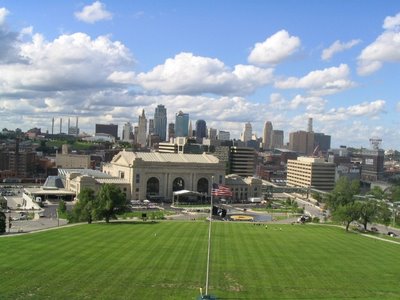
Of course I can't talk about KC and nostalgia and fail to hit the railroad presence in the city. I may have written about the Union Station before on a prior visit, but I spent some time inside today looking around, and even took their nicely-done nostalgia tour of passenger railroad history in the city. Turns out the station was built in 1914, and at that time it was the largest railroad station outside of New York City. There are a couple immense central halls, which strikes me as a design oddity, a bow to some arbitrary custom. People pass through the space on their way to somewhere else; what is the incentive to inspire and awe? Will more people ride the trains if the station is beautiful? Don't get me wrong, I'm thrilled that the money and effort were devoted to this grand public architecture, but the question remains: why?
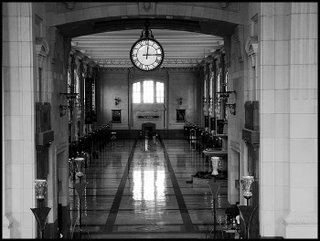 There must be space for, I suppose, several thousand people to linger, space for people and luggage to mingle and get around each other, space for restaurants and news kiosks and coffee stands. But why the cathedral-like vertical rise? Everybody smoked at the time, maybe this kept the smoke away from everyone (much cheaper to just tell people to smoke outside). Anyway, idle thoughts. The spaces are indeed huge, cavernous. Clap your hands or shout, as the gaggle of kids (in group after group) were wont to do, and the echoes go on and on. It must have been cacophonous at busy times.
There must be space for, I suppose, several thousand people to linger, space for people and luggage to mingle and get around each other, space for restaurants and news kiosks and coffee stands. But why the cathedral-like vertical rise? Everybody smoked at the time, maybe this kept the smoke away from everyone (much cheaper to just tell people to smoke outside). Anyway, idle thoughts. The spaces are indeed huge, cavernous. Clap your hands or shout, as the gaggle of kids (in group after group) were wont to do, and the echoes go on and on. It must have been cacophonous at busy times.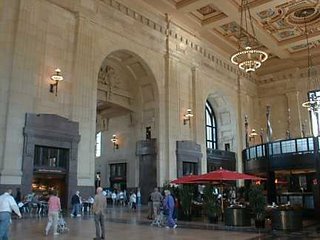 Which sounds like pretty much all the time from 1914 thru the early '50s. (I believe they also said that more rail tonnage passed through KC even today than any other city in North America, though I have to think that Chicago must give it a run for its money.) The station's heyday was during the Second World War, with half of all troops sent to fight in the conflict passing through its doors. Think of that. 300 passenger trains per day passing through KC. The pictures of that time are amazing. This is the push that made the city, the era when the Count Basie Orchestra was broadcasting from some hotel ballroom, making KC one of those fabled places people heard about on the radio.
Which sounds like pretty much all the time from 1914 thru the early '50s. (I believe they also said that more rail tonnage passed through KC even today than any other city in North America, though I have to think that Chicago must give it a run for its money.) The station's heyday was during the Second World War, with half of all troops sent to fight in the conflict passing through its doors. Think of that. 300 passenger trains per day passing through KC. The pictures of that time are amazing. This is the push that made the city, the era when the Count Basie Orchestra was broadcasting from some hotel ballroom, making KC one of those fabled places people heard about on the radio.But as I speculated above, it sounds like the demise of passenger rail traffic after WW2, which of course corresponded to the rise of the passenger airlines, starved KC of its artery of people. And money. So it really was like shutting off a tap, and the crash must have come rather precipitously, like a black reversal of the explosive growth of the city in the 70 years before from small plains settlement to bustling urban center. It's a testament to perseverance that the city has weathered this 50-year drought and is now emerging again in a new form. It is embracing its history while moving forward.
Amtrak still runs two passenger trains a day through a little office in a side corridor of the Union Station. But the train will get you only as far as St. Louis. Time marches on.
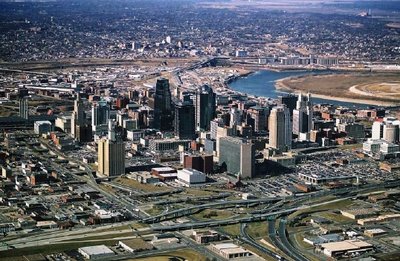
2 comments:
My family lives about three and a half hours away, and when I was a little kid, we would drive to Kansas City at Christmas to look at the Plaza, which is delicately adorned with white lights. It was the biggest city my eyes had seen--and would see for years--and seemed like a fairly magical place because of the lights. I had an aunt who lived in an apartment in KC (the building, a high rise, was named Rainbow Towers), and she seemed so sophisticated because of it. Now my opinion of KC has changed, though I have this strange fondness for the interstate rushing into the city, waiting to shoot me out on the other side as I headed east to Virginia.
I spent my first six years of life in a town of 3-4,000 people in Iowa. And Cedar Rapids or Des Moines (along with maybe Minneapolis) were The Big City. Chicago or New York were another, almost mythical thing. But I remember day trips to bigger places and how exotic and worldly it seemed. KC harks back to that, but it doesn't quite feel the same after actually spending time in Chicago and New York.
Still, a neat and formative memory.
Post a Comment